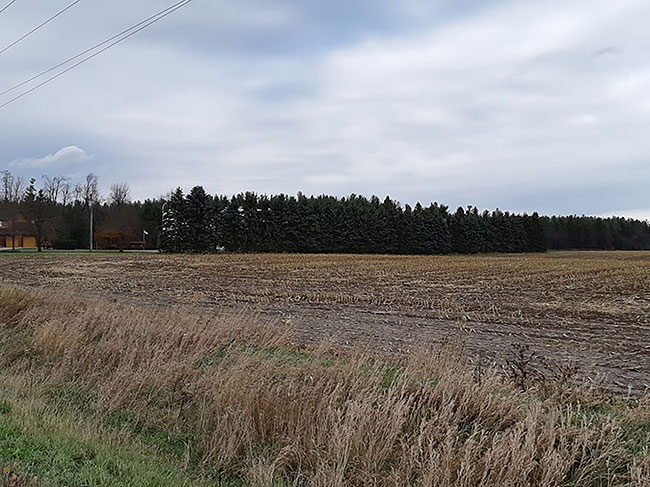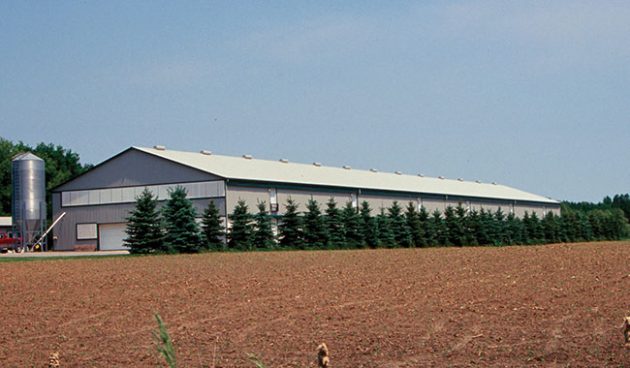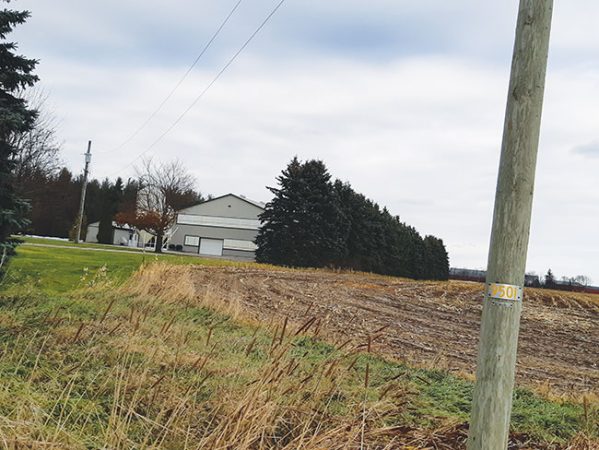
Putting trees to work on poultry barns
By Lilian Schaer
Features HealthAddressing odour and dust issues with shelterbelts.
 Research has found helterbelts can filter and mix the air and reduce windspeed to make dust and odour less noticeable.
Research has found helterbelts can filter and mix the air and reduce windspeed to make dust and odour less noticeable. Odours from manure are an unpleasant by-product of livestock and poultry production. But, research over the last decade or so has shown that there’s an effective, natural tool that can help – trees. And it’s a solution that comes with some other benefits, too.
For Todd Leuty, agroforestry specialist with the Ontario Ministry of Agriculture, Food and Rural Affairs (OMAFRA), it all started with a study completed by John Tyndall of the Department of Natural Resource Ecology and Management at Iowa State University in 2008.
Livestock production in that state had started growing rapidly in the late 1980s, particularly hogs and laying hens. According to a December 2019 report by Iowa State University Extension and Outreach, for example, Iowa’s egg industry grew 6.8-fold from 1988 to 2007 alone and eight-fold by 2018, with approximately 57.7 million hens laying 16.4 billion eggs in 2018.
The rapid expansion in the state’s livestock and poultry numbers caused growing concerns about large livestock farms and their impact on the environment, including manure and odour, dust and noise. It prompted the industry to start looking for solutions.
Proven benefits
Tyndall and other researchers began looking at the strategic use of vegetative environmental buffers, more commonly called shelterbelts, around poultry and livestock facilities and manure storages. Their intention was to assess if they helped solve the odour problems plaguing the industry and their non-farming neighbours.
Shelterbelts are trees and shrubs purposely and systematically planted in one or more rows. They can filter and mix the air and reduce windspeed to make dust and odour less noticeable.
Tyndall’s study concluded that tree-based shelterbelts can reduce odours by six to 15 per cent. What’s more, he found they can potentially lower ammonia and particulates in the air by as much as 50 per cent.
Similar research was conducted in Pennsylvania, another leading U.S. egg-producing state. Paul Patterson of Penn State University found a 67 per cent reduction in total particulate levels from a layer facility six metres downwind from a five-row shelterbelt. Junipers, for example, were found to trap more intermediate-sized particulates than willows. Related research identified spruce and hybrid willow as effective traps for dust and odour.
“Similar to how a windbreak works for snow control, you see that same effect with the dust that comes from a livestock or poultry barn that carries the odour,” Leuty explains. “Knocking the dust down by letting the trees catch it or slowing the wind down with trees helps manage dust and odour.”
“That initial research work done in Iowa State University formed a realization of how wind breaks work for odour management,” he adds. “The data they collected on odour reduction was quite striking and the results have been used by a lot of states and provinces since then.”
Trend takes hold
Tree planting was integrated into the Environmental Farm Plan as a best management practice for a variety of benefits when the popular on-farm environmental improvement program was first developed in Ontario in the 1990s. Similar programs are now available across Canada.
In Ontario, many conservation authorities have established tree planting programs to help farmers and other landowners establish windbreaks, help with soil erosion and plant treed buffer strips along water courses. The Lower Thames Valley Conservation Authority, for example, which covers an area along Lake Erie from just west of London south west to Leamington, sells between 60,000 to 80,000 trees annually. It also provides cost-share and financing options.
Shelterbelt tips
The number of rows and types of trees planted in a shelterbelt depends on the intended use of the shelterbelt. Other factors include where they will be planted and whether the livestock barns are mechanically or naturally ventilated.
To be effective for mechanically ventilated facilities, shelterbelts need to be planted at least 30 metres downwind and run the length (or width) of the barn, manure storage and other buildings on the farm as well.
For naturally ventilated barns, it’s important that the trees don’t block the air flowing towards the air inlet walls. Thus, trees should be planted perpendicular to those inlets and at least 30 metres away from the building.
For management of farm-related odours and other air emissions, Alberta Agriculture and Rural Development, for example, recommends a minimum of three to six rows, depending on municipal zoning regulations and whether a farm’s neighbours are agricultural or residential.
Two to five rows of appropriately-spaced spruce conifers can provide an ideal 50 per cent density (or 50 per cent porosity) through the tree canopy. Shelterbelts are less effective for odour reduction when wind is absent, Leuty says, but they still provide many of the other benefits.
He recommends conifers as the best tree species for shelterbelts, specifically: White, Norway, Colorado Blue or Serbian spruce; White, Austrian or Scotch pine; and Eastern White cedar. Not only do they absorb gases and dissolve pollutants and are green year-round, their needles have a thick, waxy coating that makes them better able to survive winter road salt use.
Healthy return
Similar to Tyndall’s conclusions in Iowa, Leuty says the cost for Canadian farmers to establish shelterbelts is reasonable and it’s an investment with long-term benefits for any type of livestock barn, manure storage, methane digester or farm source of dust.
“There are many cost-share programs that make it manageable – if a farmer invests $2,000 to $3,000 for a good windbreak, it will pay off for many years down the road,” he says. “That could be 30 years if the trees are managed properly.”
It takes four to five years for trees to solidly establish depending on the type of trees that are planted, and five to six years to start seeing an effect if farmers start with smaller trees. Larger trees can be transplanted yielding quicker results but requiring a larger up-front investment.
Although shelterbelts take time to establish, once fully grown, they can provide benefits even beyond air emission control. These include shielding barns and manure storages from view, reducing the heating and cooling costs of poultry and livestock facilities and other farm buildings and preventing snow drifts on roadways.
Print this page

